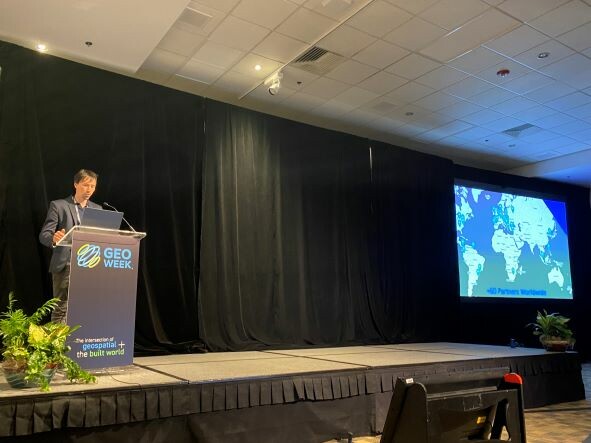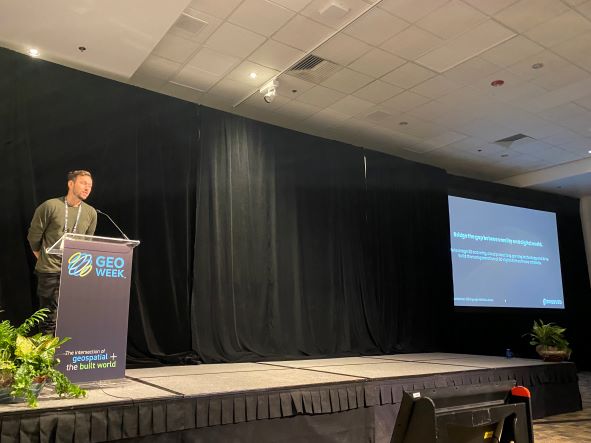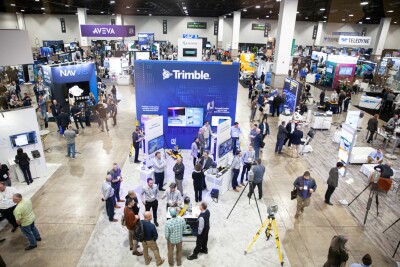February 11-13, 2024 | Colorado Convention Center | Denver, CO, USARegistration is Open for Geo Week 2024!
These products ran the gamut in terms of what attendees can see throughout the exhibit hall at this event, ranging from laser scanning hardware to photogrammetry software to tool for the AEC industry and everything in between. We’ll be highlighting all of these products over the next three days, with a focus today on companies offering innovative software to geospatial, AEC, and other professionals.
Prevu3D
Prevu3D aims to make digital twins accessible to all who can benefit, focusing specifically on ensuring even non-technical users can get real value from their software. A web-based platform which can be run on any standard laptop, they ran through some of the top and newest features in their program. Using point cloud data largely within large facilities like auto manufacturing and food and beverage plants, a user can fully interact with these models, including with a customizable avatar. The company showed off the gaming engine-powered models, an ability to place assets within a model, and their newest feature which allows for automated segmentation. All of this, too, came just a day before Tuesday’s announcement that the company had raised $10 million in funding to enhance the product even more.
Matterport
One of the biggest names in digital twins and enhancing accessibility, Matterport not only presented on their software solutions but also hardware offerings, ultimately showcasing a full workflow. On the hardware side, the presentation focused largely on their Pro3 camera, released last August and really designed for that digital twin creation. While the company has largely focused on image-based digital twin creation, this new camera combines traditional imagery with lidar to create the foundation for digital twins. That captured data combined with some of their software offerings to create floorplans and 3D models gives easy access to a usable digital twin platform.
3Dsurvey
One thing that becomes readily apparent listening to the people at 3Dsurvey talking about their point cloud software offerings is their experience in the field. The 3Dsurvey team is almost entirely made up of experienced surveyors who truly understand problems professionals are facing, and it comes across in this offering. Talking through some of their key features, the company highlighted its product’s ability to easily calculate volume, extracting building corners with their X-Ray functionality, a seamless ability to switch back and forth between mesh and point cloud, and contour lines, among other features. Not a simple product in terms of power, it is intuitive, and they also let the audience know they offer free training sessions as well.

Blue Marble Geographics
Compared to some of the other companies we’ve discussed thus far in this recap, Blue Marble Geographics separates themselves a bit by specializing in GIS data. In this event, the company presented their Global Mapper Pro product, an all-in-one GIS platform. The software allows for data creation, editing, advanced 2D and 3D analysis, scripting methods for workflow automation, and expansive file format support. Blue Marble’s team also highlighted some of the newest features on the platform, such as relative elevation models to highlight terrain variation, new inset map elements, and mobile data management capabilities, among plenty of other new features. In addition to Global Mapper Pro, they also touched on their Geographic Calculator, a geodetic software for accurate coordinate conversion, datum transformation, and file translation.
Esri
There is no name bigger in the world of geospatial software than Esri, and at this year’s Geo Week event they announced the release of their new ArcGIS Reality product. During their presentation, the company highlighted much of their ArcGIS platform, with a special focus on this new reality engine. This provides the foundation for large-scale digital twins, pulling in existing products like SiteScan and Drone2Map, both of which utilize drone mapping, as well as new releases with ArcGIS Reality for ArcGIS Pro and ArcGIS Reality Studio. Providing a full workflow from captured data to processing to extraction, complete with artificial intelligence and machine learning, as well as ability to integrate CAD and BIM data, Esri’s newest release impressed those in attendance.
Cintoo
Continuing with the theme of digital twin software, Cintoo presented on their Cintoo Cloud platform for digital twin creation. One of the coolest things about the Cintoo platform is their ability to really shrink down files by 20 to 30 times, making them easily shareable through the cloud. They also note, crucially, that this can be reversed so those receiving the data can revert it back to its original form if necessary for their project. Cintoo prides itself on making their software scanner-agnostic, and look to merge the worlds of Industry 4.0 and BIM platforms to provide as much value as possible to their users. The team also discussed their newest AI capabilities for feature extraction as well as their full workflow of integrations with the top names in the industry at every stage of a project.
Bentley Systems
There are few companies who understand the technological needs of the AEC industry like Bentley Systems, and they were on hand to discuss their iTwin platform and their ContextCapture software which allows for the quick creation of digital twins from point cloud and/or photogrammetric data. They boasted about their fastest processing times on the market, combined with their own AI and machine learning capabilities. And ultimately, they talked about the significance of adding that “fourth dimension” of context into their models with things like IoT sensors and other real-time information which can be fed into their digital twins.
TopoDOT
Drawing on their three decades of experience in the lidar industry, TopoDOT presented about their point cloud processing software. In the presentation, they discussed the importance of having quality control and assurance in a workflow, either during or after extraction, both of which their software offers. Like most others in the field, they are working more with AI for feature extraction, but did stress the importance of combining automation and quality. Speed is good, but only if you’re getting the returns you’re expecting and need. In addition to their point cloud processing software, they also discussed their TopoShare tool to enhance collaboration within teams and between stakeholders.






